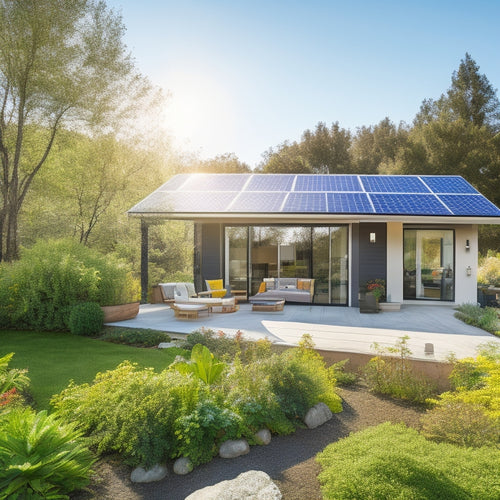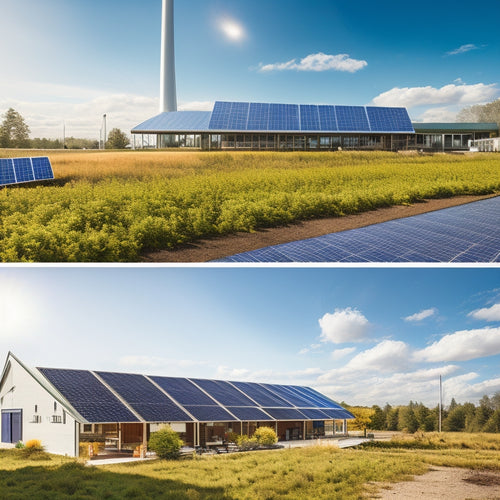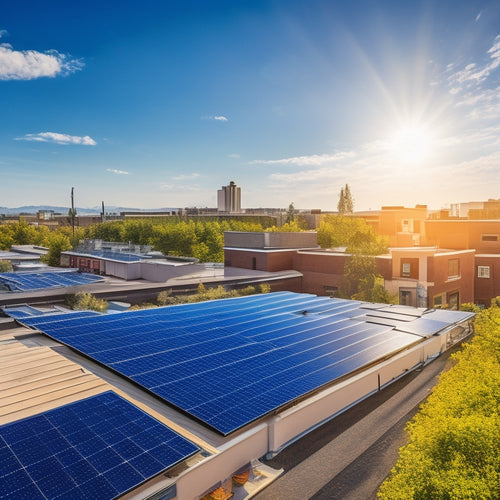
How Does the Cost of Solar Energy Compare to Traditional Sources?
Share
You're likely to pay around 6 to 8 cents per kilowatt-hour for solar energy, making it increasingly competitive with traditional sources. Compared to coal, solar energy is more attractive, with a true cost of coal electricity generation sitting at around 26 cents per kWh. Solar also offers a stable, predictable cost structure compared to the fluctuating prices of natural gas. While nuclear energy has high upfront investment requirements, declining solar panel installation costs make solar more accessible. As you investigate the cost terrain of energy sources, you'll find that the advantages of solar energy become even more apparent, and its benefits extend far beyond the initial investment.
Key Takeaways
- Solar energy costs 6-8 cents per kWh, compared to coal's true cost of approximately 26 cents per kWh.
- Solar energy offers a stable cost structure, unlike natural gas prices which are influenced by market instability.
- The high upfront investment required for nuclear energy makes solar a more accessible and affordable option.
- The cost of solar energy has decreased by over 70% in the last decade, making it competitive with fossil fuels in many regions.
- Financial incentives, such as federal tax credits and solar rebates, can significantly reduce the initial costs of solar energy installation.
Understanding Solar Energy Costs
As you consider shifting to solar energy, understanding the costs involved is essential to making an informed decision. The upfront costs of solar energy can be broken down into two main categories: solar panel pricing and installation expenses.
Solar panel pricing varies depending on the type and quality of panels, with high-efficiency panels typically costing more. On average, the cost of solar panels ranges from $2.50 to $3.50 per watt. For a typical residential solar panel system, this translates to a total cost of around $15,000 to $25,000.
Installation expenses, including labor, mounting hardware, and inverters, account for a significant portion of the overall cost. These expenses can range from $2,000 to $10,000, depending on the complexity of the installation and local labor rates.
However, incentives such as tax credits and rebates can help offset these costs. By understanding these costs, you can accurately assess the financial viability of solar energy for your specific needs.
Traditional Energy Sources Overview
Traditional energy sources, including fossil fuels and nuclear power, have long dominated the global energy panorama. You're likely familiar with these sources, which have been the backbone of modern civilization for centuries.
Fossil fuels, such as coal, natural gas, and oil, account for approximately 85% of the world's energy production. Nuclear power, another significant contributor, generates around 10% of global electricity.
While traditional energy sources have propelled economic growth and industrialization, they come with significant environmental costs. The burning of fossil fuels releases massive amounts of greenhouse gases, contributing to climate change and air pollution.
Nuclear power, on the other hand, poses risks associated with radioactive waste disposal and nuclear accidents.
As the world shifts towards a more sustainable future, renewable energy sources like solar power are gaining traction. You may be wondering how these newer sources compare to traditional energy regarding cost.
In the following sections, we'll explore the cost comparison between traditional energy sources and solar energy, examining the economic and environmental implications of each.
Coal Energy Price Comparison
Coal, the most widely used fossil fuel, accounts for approximately 38% of global electricity generation. You might think it's a cheap option, but the cost of generating electricity from coal is more complex than you'd expect. The cost of coal mining, transportation, and burning adds up quickly. On average, the cost of generating electricity from coal ranges from 3-5 cents per kilowatt-hour (kWh).
However, this doesn't factor in the significant emissions impact of coal-fired power plants, which are a major contributor to greenhouse gas emissions and air pollution.
When you evaluate the external costs of coal, such as environmental degradation and health issues, the true cost of coal energy skyrockets. In fact, a study by the National Academy of Sciences estimated that the total cost of coal, including these externalities, could be as high as 26 cents per kWh.
This makes solar energy, with its average cost of 6-8 cents per kWh, a more attractive option for those looking to reduce their carbon footprint and energy costs. As you weigh your energy options, it's crucial to assess the complete scenario, including the hidden costs of traditional energy sources like coal.
Natural Gas Cost Analysis
You'll want to evaluate the natural gas cost analysis in your comparison of solar energy costs, as it's a significant factor in the overall energy market.
Natural gas prices have been volatile in recent years, and you've likely seen the impact of this fluctuation on your energy bills.
As extraction costs continue to rise, it's crucial to understand how these factors influence the cost of natural gas as an energy source.
Gas Price Volatility
As you examine the cost of solar energy, it's vital to evaluate the natural gas cost analysis, particularly when it comes to gas price volatility.
Gas price fluctuations have significant implications for energy market instability, leading to unpredictable energy prices and affecting consumer wallets. Geopolitical factors, such as supply chain disruptions and global events, contribute to these fluctuations, making it challenging to project future energy costs.
The environmental implications of gas price volatility are also significant. As gas prices rise, the demand for alternative fuels increases, driving innovation in sustainable energy sources.
However, when gas prices drop, the incentive to invest in clean energy diminishes, hindering progress toward a low-carbon future. To mitigate this uncertainty, it's important to assess the long-term benefits of solar energy, which offers a stable, predictable cost structure.
Extraction Costs Rise
Rising extraction costs are altering the natural gas cost analysis, further complicating the already complex energy market.
You're likely aware that natural gas extraction methods have become more costly due to declining well productivity and increasing drilling complexity. As a result, the cost of extracting natural gas is on the rise, which directly impacts the overall cost of energy production.
Market fluctuations also play a significant role in natural gas cost analysis. As global demand increases, prices rise, making it more expensive to extract and transport natural gas.
Additionally, the cost of extracting natural gas from shale formations, which accounts for a significant portion of US natural gas production, is higher than traditional extraction methods.
These rising extraction costs and market fluctuations contribute to the volatility of natural gas prices, making it challenging to predict energy costs.
As you consider the cost of solar energy compared to traditional sources, it's crucial to factor in these increasing extraction costs and market uncertainties to make an informed decision.
Nuclear Energy Cost Breakdown
You'll find that nuclear energy's capital expenditure costs are substantial, primarily due to the high upfront investment required for building a nuclear power plant.
These costs include land acquisition, construction, and installation of equipment, which can range from $5,000 to $15,000 per kilowatt of installed capacity.
Additionally, you'll need to evaluate operational expenses, such as fuel, maintenance, and waste disposal, which can add up to $30 to $50 per megawatt-hour of electricity generated.
Capital Expenditure Costs
When building a nuclear power plant, capital expenditure costs account for the lion's share of the overall expenses. These upfront costs include land acquisition, construction, and equipment expenses. The average capital expenditure cost for a nuclear power plant is around $5,000 per kilowatt, making it a considerable investment.
In contrast, the cost of solar panel installation has decreased markedly over the years, with the average cost per watt ranging from $2.50 to $3.50. Financing options, such as power purchase agreements and community solar programs, have also made solar energy more accessible and affordable.
As you consider investing in nuclear or solar energy, it's crucial to evaluate the capital expenditure costs and the potential return on investment. While nuclear energy provides a stable and reliable source of power, the high upfront costs can be a considerable barrier.
On the other hand, solar energy offers a more affordable option with lower capital expenditure costs, making it an attractive alternative for many businesses and individuals. By understanding the capital expenditure costs associated with each option, you can make an informed decision that aligns with your energy goals and budget.
Operational Expenses
Approximately 70% of the total nuclear energy cost is attributed to operational expenses, which include fuel costs, maintenance, and personnel expenses.
You'll find that fuel costs account for around 25% of operational expenses, with the remaining 75% split between maintenance and personnel expenses. Maintenance expenses are a significant component, as they include regular upkeep, repairs, and replacement of equipment to guarantee efficient operation.
You'll need to take into account these expenses when evaluating the overall cost of nuclear energy.
To reduce operational expenses, you can focus on efficiency improvements. Implementing advanced technologies, such as digital control systems and automation, can help minimize maintenance expenses.
Additionally, optimizing fuel cycle management and waste disposal practices can also lead to cost savings. By prioritizing efficiency improvements, you can reduce the overall cost of nuclear energy and make it a more competitive option.
Renewable Energy Cost Trends
Renewable Energy Cost Trends
You're likely wondering how the cost of solar energy compares to traditional sources over time. The trend is clear: renewable energy costs are declining rapidly. According to a renewable investment analysis, the cost of solar energy has dropped by over 70% in the last decade, making it more competitive with fossil fuels.
Here are three key takeaways about solar energy trends:
-
Solar module prices have fallen by 90%: This significant drop in prices has driven the growth of the solar industry, making it more accessible to consumers and businesses alike.
-
The cost of solar energy is now competitive with fossil fuels: In many parts of the world, the cost of solar energy is equal to or lower than traditional sources, making it a viable alternative.
-
Renewable energy is becoming the norm: As the cost of renewable energy continues to decline, it's becoming the preferred choice for new power generation, accounting for over 30% of global power generation in 2020.
Financial Incentives for Solar
As the cost of solar energy continues to decline, you're likely considering how to take advantage of this trend. Fortunately, there are various financial incentives available to help you do so.
For starters, you can claim federal tax credits, which cover up to 26% of your solar installation costs. Additionally, state incentives and solar rebates can provide further savings.
Financing options are also available, including green loans and solar leasing, which allow you to install solar panels with little to no upfront cost.
Furthermore, net metering policies enable you to sell excess energy back to the grid, reducing your utility bills. As an investor, you can benefit from investment tax credits and renewable energy certificates, which enhance the return on your investment.
Lastly, community solar programs allow you to join forces with neighbors to share the costs and benefits of a single solar array.
Frequently Asked Questions
Can I Sell Excess Energy Generated by My Solar Panels?
You can sell excess energy generated by your solar panels through net metering benefits, where you're credited for the excess, or energy buyback programs, where you're paid for the surplus, depending on your utility company's policies and local regulations.
How Long Does It Take for Solar Panels to Pay for Themselves?
You'll recoup your solar panel investment through lower electricity bills, with a typical solar payback period ranging from 5-10 years, depending on your location, system size, and energy usage, as revealed by a thorough investment analysis.
Are Solar Panels Resistant to Extreme Weather Conditions?
You'll be relieved to know that solar panels are designed to withstand extreme weather conditions, boasting impressive durability. They can resist hail, high winds, and heavy snow loads, ensuring peak performance even in harsh climates, with some panels certified to withstand up to 1-inch hailstones.
Can I Install Solar Panels on a Rented Property?
You'll need to secure landlord permission before installing solar panels on a rented property, and consider negotiating solar panel agreements that benefit both parties, ensuring a mutually beneficial arrangement that works for you and your landlord.
Do Solar Panels Require Regular Maintenance?
You'll be thrilled to know that solar panels are virtually maintenance-free, but you'll still need to perform routine inspections every 6-12 months to guarantee peak performance, extending their lifespan of 25-30 years or more.
Conclusion
As you weigh the cost of solar energy against traditional sources, imagine the sun's rays illuminating a path to a cleaner, more sustainable future. The data speaks for itself: solar energy is becoming increasingly competitive with coal, natural gas, and nuclear power. With financial incentives and declining costs, the scales are tipping in favor of renewables. The light at the end of the tunnel is no longer a distant dream, but a tangible reality, beckoning you to utilize the power of the sun.
Related Posts
-

Green Home Improvements Using Solar Power
Investing in solar power alters your home into a sustainable haven while slashing energy costs. You can greatly reduc...
-

Off-Grid Solar Solutions for Eco-Conscious Businesses
Off-grid solar solutions offer you a path to both sustainability and substantial cost savings. By adopting these syst...
-

Solar Energy Solutions for Small Businesses
Switching to solar energy can be a game changer for your small business. You'll enjoy significant cost savings on mon...


